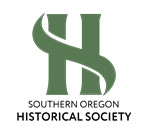Daniel Major uses a sextant and crew of 19 to track 42nd Parallel to the Pacific shore.
The U.S. General Land Office hired Daniel Major in 1868 to survey the Oregon-California Line.
Major used a sextant and a crew of 19 to locate the intersection of Nevada, California and Oregon, which he marked by placing three large black bottles and a cottonwood stake surrounded by rocks. He also erected a sandstone monument with the states’ names engraved on the sides.
Continuing west, Major tracked the 42nd parallel all the way to the Pacific. Near today’s I-5, the surveyors marked the intersection of the “Emigrant Road to Jacksonville.”
Major struggled to maintain a straight course in the mountains and through what he called “damnable brush.” Snow in the high Siskiyous in December made his route almost impassable. He postponed the survey for the remainder of the winter when he reached Elliot Creek Ridge, east of today’s Applegate Lake. The following June, Major’s crew returned to the ridge and eventually completed the survey to the coast.
Using new technology, Major’s successors discovered that the border continuously meandered north and south of the true 42nd parallel. Despite that, most of Major’s original survey is still used today to designate the Oregon-California line.
Sources: Davy, Sir Humphry. Report of the Superintendent of the U.S. Coast and Geodetic Survey. Smith, Elder, and Company, 1901. Web. 20 Nov. 2014; LaLande, Jeffrey M. Prehistory and History of the Rogue River National Forest: A Cultural Resource Overview. Medford, OR: Rogue River National Forest, 1980. Web. 20 Nov. 2014.
The SOHS Library is OPEN to the public at 106 N. Central Avenue in Medford, with FREE access to the SOHS Archives, from 12:00 - 4:00 pm, Tuesday through Saturday. Appointments are not necessary. Please contact library@sohs.org, or call 541-622-2025 ex 200 to ask questions or request research.
Early Surveyor Marks Meandering Oregon-California Line
Episode
2574
Date
